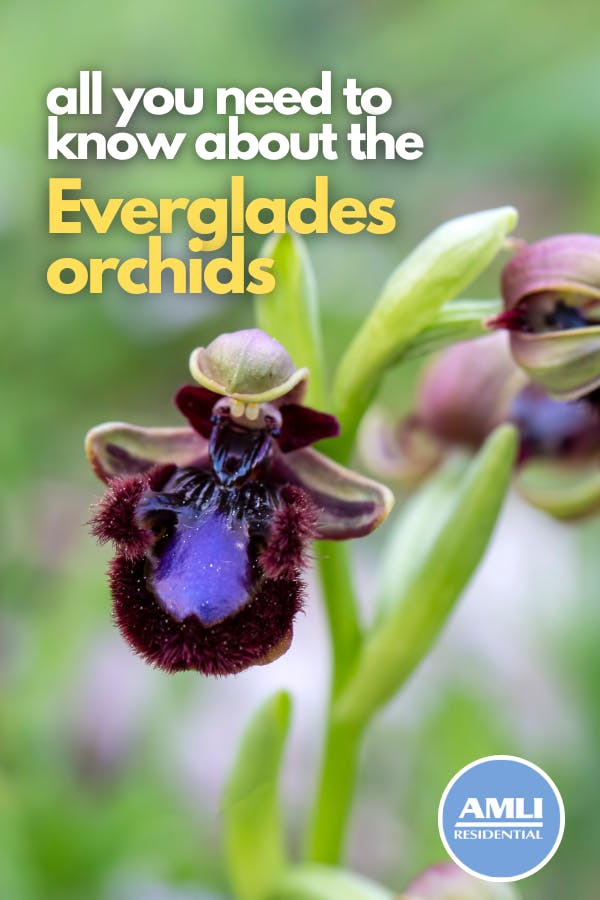The Everglades National Park is renowned for its remarkable biodiversity. Animals ranging from panthers to alligators to manatees and armadillos feast on the 650+ species of plants found in the park, while over 360 species of birds nest and rest in the canopies and branches over the nine habitats across the region.
There’s so much life and diversity in the Everglades that it’s no wonder orchids are also a part of this amazing ecosystem. In fact, the Everglades National Park boasts the highest orchid diversity of any National Park Service site in the continental United States with over 39 species of orchids calling the park home, thriving in the park's warm, humid climate.
Here’s all you need to know about these fascinating flowers found in the Florida forests.
Looking for orchids in the Everglades
The two main types of Everglades orchids
Orchids can be broadly categorized into two distinct groups based on their preferred growing location: terrestrial orchids and epiphytic orchids.
Terrestrial orchids (quite literally meaning "earth-dwelling”) grow on the ground like most other plants. These types of orchids can be found carpeting pineland ecosystems and grassy forests with their small, colorful flowers, like the vibrant pink blossoms of the tuberous grass pink orchid. The dense canopy and rich soil in hardwood hammock ecosystems also provide ideal habitats for terrestrial orchids, since there’s enough moisture and nutrients in the soil to grow without being drowned or munched on by hungry amphibians. Here, extra-diligent orchid seekers might catch a glimpse of the native longclaw orchid with its tiny white flowers and delicate green and brown speckled leaves.
Epiphytic orchids take a more unconventional approach to anchoring their growth. Also known as air plants, epiphytic plants utilize branches, trees, logs and rocks as a platform, foregoing the need for soil entirely! Being able to grow on trees and other solid structures allows these kinds of orchids to access sunlight above the dense understory vegetation and capitalize on any moisture and nutrients carried by rainwater and debris, which is helpful when competing for sunlight in crowded wetlands and swamps!
The wispy butterfly orchid is a great example of a well-established epiphytic orchid. Their small, orange flowers grow in large groups on trees all over the Everglades, wrapping the trunks tightly with their long tangled roots.
Interestingly, some seemingly terrestrial orchids like the spring ladies' tresses (these are some of the first orchids to bloom in the spring!) are actually epiphytes in disguise. These clever plants may appear to sprout from the ground but are actually perched upon it or rooted directly to underlying rock formations or logs under the soil. Neat!
The elusive and endangered ghost orchids
Among the Everglades' many orchid varieties, none is as captivating, as well-known or as threatened as the ghost orchid. Unlike its vibrant cousins, the pure-white ghost orchid is entirely devoid of leaves — a unique adaptation allowing it to minimize water loss in the harsh South Florida sun. Its intricate, silvery-looking root system anchors the leafless plant to cypress and pond apple trees, uses photosynthesis to produce food in the sunlight and grows only when a certain type of fungus is present. Picky, huh?
The ghost orchid's crowning glory, though, is its breathtaking, short-lived flower. Ghostly white with a hint of lavender, the sprite-shaped flower releases a sweet, intoxicating fragrance only at night to attract nocturnal moths who pollinate the flowers and collect the nectar. Its name comes both from the color and for the fact that the flower seems to float in midair at night, thanks to its well-camouflaged root system hidden against the tree.
Sadly, the ghost orchid's specific needs and habitat destruction have pushed it to the brink of extinction. Poachers hunting for the elusive flower have also significantly impacted the population, so seeing one of these special flowers might be one of the most unique things you spot while exploring the Everglades!
Why are orchids important to the Everglades?
The presence of orchids in the Everglades extends far beyond their aesthetic appeal — though, to be fair, that’s a pretty large contribution in its own right.
These remarkable plants play a vital role in the intricate web of the park's ecosystem. Orchids serve as a food source for various insects, including specialized pollinators attracted by their unique colors and fragrances. In turn, these pollinators ensure the orchids' reproductive success by transferring pollen between flowers as they eat to sustain their own populations. Some terrestrial orchid species also form mutually-beneficial relationships with mycorrhizal fungi, exchanging nutrients and water for the benefit of both partners.
This system of interactions as part of small, area-specific food chains contributes to the health and biodiversity of the Everglades ecosystem as a whole, sustaining the lives of birds, mammals, reptiles, amphibians and fish all over South Florida!
How to go looking for orchids in Everglades National Park
For visitors eager to witness the beauty of the Everglades’ orchids firsthand, careful planning and responsible wildlife viewing practices are your keys to success.
As with most wildflower-centered excursions, the best time to visit depends on the specific orchid species you want to see. The spring months between March and May are ideal for spotting early bloomers like the grass pink orchid and the spring ladies' tresses. Warmer summer weather from June to August brings out the vibrant butterfly orchid, while cooler temperatures during September to November offers a chance to glimpse the elusive ghost orchid.
Whether you’re looking for a rare orchid or a common one, it’s important to do your best to ensure minimal disruption to the Everglades’ already delicate ecosystem. Stay on designated trails and refrain from touching or picking the orchids while you’re exploring, or go on a guided tour with a park ranger or naturalist who can take you directly to the good stuff! However you choose to enjoy the orchids, please do so respectfully and with the survival of these plants in mind.
The orchids of Everglades National Park are a testament to the power of natural adaptation, the delicate balance of ecosystems and the sheer beauty of the natural world. From the vibrant displays of common terrestrial orchids on the forest floor to the ethereal ghost orchid clinging to the trees, these captivating plants add a layer of elegant beauty to the Everglades and play a large role in the survival of the plants and animals that call it home. If you live in or near our luxury South Florida apartments, then you have a unique opportunity to see this display of wildlife with your own eyes just a few miles away from home!
Good luck!
Pin it!

Featured photo by Ivan Samudra on Unsplash


 View All Posts by Colleen Ford
View All Posts by Colleen Ford